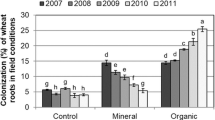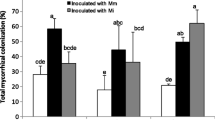Abstract
The growth and mineral nutrition responses were evaluated of three tropical legumes, cowpea (Vigna unguiculata L. cv Kuromame), pigeonpea [Cajanus cajan L. (Millsp.) cv ICPL 86009] and groundnut (Arachis hypogaea cv Nakateyutaka) inoculated with two different species of VAM fungi, Glomus sp. (Glomus etunicatum-like species) and Gigaspora margarita, and grown in Andosols with different fertilities [Bray II-P: topsoil (72 ppm), subsoil (<0.1 ppm)]. Percent fungal root colonization was high in cowpea and groundnut but relatively low in pigeonpea in both soil types. Despite the low rate of root infection, significant growth responses were produced, especially in the inoculated pigeonpea plant. In all legumes, shoot dry matter production was favoured by the inoculations. Increases in shoot biomass due to mycorrhizae were greater in the subsoil than in the topsoil. Mycorrhization raised shoot concentrations of P and Ca (in cowpea and groundnut) and P and K (in pigeonpea) in the topsoil. Whereas the P concentration in shoots in the subsoil was not positively affected by VAM fungi, particularly in cowpea and pigeonpea, the concentration of K in such plants was significantly increased by VAM treatment. The results also showed that mycorrhizal enhancement of shoot micronutrient concentrations was very rare in all plants, with negative effects observed in certain cases. Cu concentration, in particular, was not affected by VAM formation in any of the plants, and Mn and Fe in pigeonpea and groundnut, respectively, remained the same whether plants were mycorrhizal or not. In both soils the three legumes responded to Glomus sp. better than to Gigaspora margarita, and the effects of the VAM fungi on each of the crops relative to the controls were greater in the subsoil than in the topsoil. However, shoot growth of groundnut was not affected as much as cowpea and pigeonpea by the type of soil used. In spite of the relatively low infection of its root, pigeonpea was generally the most responsive of the three legume species in terms of mycorrhizal/nonmycorrhizal ratios.
Similar content being viewed by others
References
Carling DE, Riehle WG, Brown MF, Johnson DR (1978) Effects of a vesicular-arbuscular mycorrhizal fungus on nitrate reductase and nitrogenase activities in nodulating and non-nodulating soybeans. Phytopathology 68:1590–1596
Cooper KM (1984) Physiology of VA mycorrhizal association. In: Powell CL, Bagyaraj DJ (eds) VA mycorrhiza. CRC Press, Boca Raton, Fla, pp 155–186
Daft MJ, El-Giahmi AA (1976) Studies on nodulated and mycorrhizal peanuts. Ann Appl Biol 83:273–276
Gerdemann JW (1964) The effects of mycorrhiza on the growth of maize. Mycologia 54:342–349
Giovanetti M, Mosse B (1980) An evaluation of techniques for measuring vesicular-arbuscular mycorrhizal infection in roots. New Phytol 84:489–500
Janos DP (1987) VA mycorrhizas in humid tropical ecosystems. In: Safir GR (ed) Ecophysiology of VA mycorrhizal plants. CRC Press, Boca Raton, Fla, pp 107–134
Jarrell WM, Beverly RB (1981) The dilution effect in plant nutrition studies. Adv Agron 34:197–224
Koch KE, Johnson CR (1984) Photosynthate partitioning in splitroot citrus seedlings with mycorrhizal and non-mycorrhizal root systems. Plant Physiol 75:26–30
Kormanik PP, McGraw AC (1982) Quantification of vesicular-arbuscular mycorrhizae in plant roots. In: Schenck NC (ed) Methods and principles of mycorrhizal research. American Phytopathological Society, St Paul, Minn, pp 37–45
Krishna KR, Bagyaraj DJ (1984) Growth and nutrient uptake of peanut inoculated with the mycorrhizal fungus Glomus fasciculatum compared with non-inoculated ones. Plant Soil 77:405–408
Manjunath A, Bagyaraj D (1984) Response of pigeonpea and cowpea to phosphate and dual inoculation with vesicular-arbuscular mycorrhiza and Rhizobium. Trop Agric Trinidad 61:48–52
Mengel K, Kirkby EA (1987a) Phosphorus in physiology. In: Mengel K, Kirkby EA (eds) Principles of plant nutrition, 4th edn. International Potash Institute, Bern, Switzerland, pp 414–420
Mengel K, Kirkby EA (1987b) Calcium in physiology. In: Mengel K, Kirkby EA (eds) Principles of plant nutrition, 4th edn. International Potash Institute, Bern, Switzerland, pp 461–474
Mosse B (1957) Growth and chemical composition of mycorrhizal and non-mycorrhizal apples. Nature (London) 179:922–924
Murphy J, Riley JP (1962) A modified single solution method for the determination of phosphate in natural waters. Anal Chem 27:31–36
Murphy LS, Ellis R Jr, Adriano DC (1981) Phosphorus-micronutrient interaction effects on crop production. J Plant Nutr 3:593–613
Nielsen JD, Jensen A (1983) Influence of vesicular-arbuscular mycorrhiza fungi on growth and uptake of various nutrients as well as uptake ratio of fertilizer P for lucerne (Medicago sativa). Plant Soil 70:165–172
Pacovsky RS, Fuller G (1986) Development of two endomycorrhizal symbioses on soybean and comparison with phosphorus fertilization. Plant Soil 95:361–377
Pacovsky RS, Bethlenfalvay GJ, Paul EA (1986a) Comparison between phosphorus-fertilized and mycorrhizal plants. Crop Sci 26:151–156
Pacovsky RS, Paul EA, Bethlenfalvay GJ (1986b) Response of mycorrhizal and P-fertilized soybeans to nodulation by Bradyrhizobium or ammonium nitrate. Crop Sci 26:145–150
Pang PC, Paul EA (1980) Effects of vesicular-arbuscular mycorrhiza on 14C and 15N distribution in nodulated faba beans. Can J Soil Sci 60:241–250
Raju PS, Clark RB, Ellis JR, Maranville JW (1990) Mineral uptake and growth of sorghum colonized with VA mycorrhiza at varied soil phosphorus levels. J Plant Nutr 13:843–859
Routien JB, Dawson RF (1943) Some interrelationships of growth, salt absorption, respiration and mycorrhizal development in Pinus echinata Mill. Am J Bot 30:440–451
Simpson D, Daft MJ (1990) Spore production and mycorrhizal development in various tropical crop hosts infected with Glomus clarum. Plant Soil 121:171–178
Snellgrove RC, Splittstoesser WE, Stribley DP, Tinker PB (1982) The distribution of carbon and the demand of the fungal symbiont in leek plants with vesicular-arbuscular mycorrhizas. New Phytol 92:75–87
Stribley DP (1987) Mineral nutrition. In: Safir GR (ed) Ecophysiology of VA mycorrhizal plants. CRC Press, Boca Raton, Fla, pp 59–70
Van Nuffelen M, Schenck NC (1984) Spore germination, penetration, and root colonization of six species of vesicular-arbuscular mycorrhizal fungi on soybean. Can J Bot 62:624–628
Watanabe FS, Olsen SR (1965) Test of an ascorbic acid method for determining phosphorus in water and NaHCO3 extracts from soil. Soil Sci Soc Am Proc 29:677–678
Author information
Authors and Affiliations
Rights and permissions
About this article
Cite this article
Ahiabor, B.D., Hirata, H. Characteristic responses of three tropical legumes to the inoculation of two species of VAM fungi in Andosol soils with different fertilities. Mycorrhiza 5, 63–70 (1994). https://doi.org/10.1007/BF00204021
Issue Date:
DOI: https://doi.org/10.1007/BF00204021




